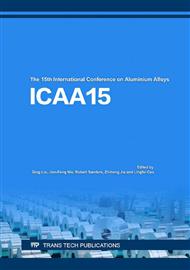p.380
p.387
p.393
p.400
p.409
p.416
p.421
p.427
p.437
Effect of Dispersoids on Long-Term Stable Electrical Aluminium Connections
Abstract:
In electrical power systems bolted joints with bus bars made of aluminium are common, whereby the tendency towards higher operating temperatures can be observed. At higher temperatures a reduction of the joint force can occur due to creep and/or stress relaxation processes, which leads to an increasing electrical resistance and, in the worst case, to failed joints. The aim of this project is to increase the creep resistance (and to minimise the stress relaxation) of aluminium conductors for electrical applications without a significant reduction in their electrical conductivity – even after long-term exposure to elevated temperatures. The effect of dispersoids in different aluminium alloys on the longterm behaviour of currentcarrying joints at high temperatures (i.e. 140 °C) was investigated. Longterm tests on bolted joints with force measuring devices were performed to monitor the joint forces and to measure the joint resistances, both with and without current supply.
Info:
Periodical:
Pages:
409-415
Citation:
Online since:
November 2016
Price:
Сopyright:
© 2017 Trans Tech Publications Ltd. All Rights Reserved
Share:
Citation:


